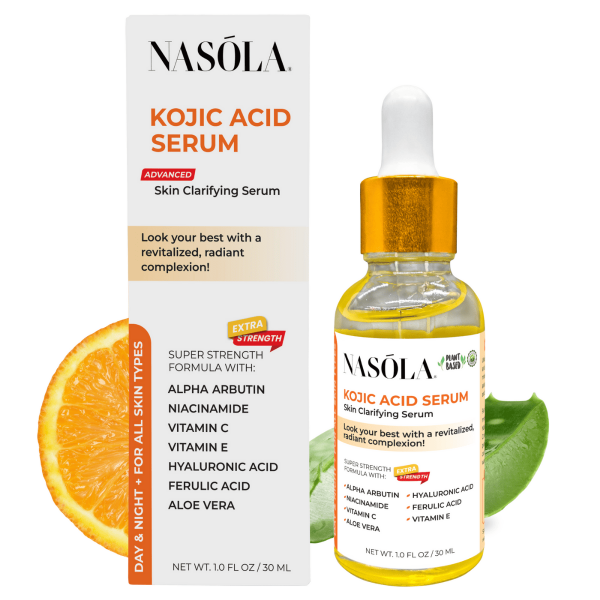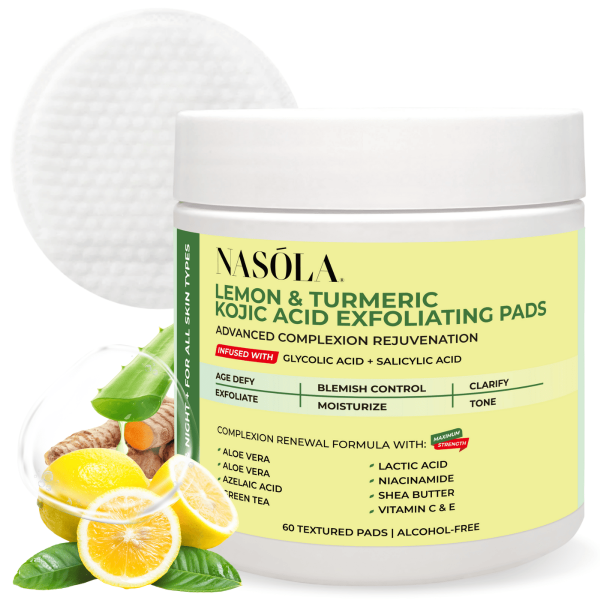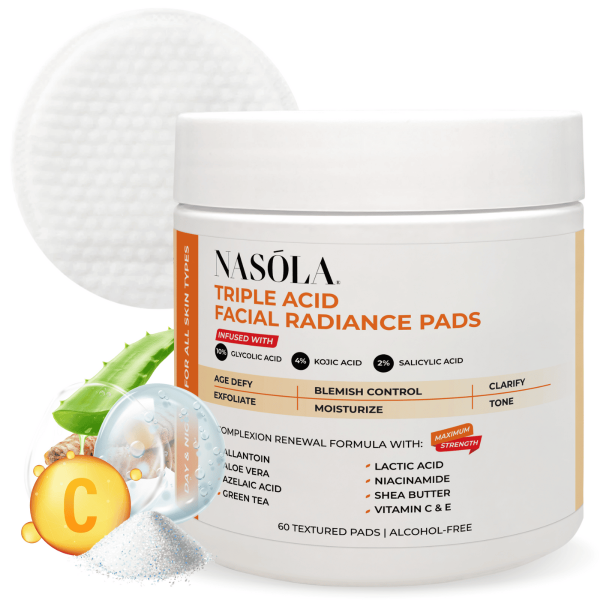Hyperpigmentation shows up uninvited. And worse? It overstays its welcome.
If you’ve tried everything from lemon juice folklore to pricey treatments that promise but never deliver, you’re not alone. What if I told you there’s a gentle but power-packed acid—yes, an acid—that works FOR your skin, not against it? Introducing a game-changer: mandelic acid hyperpigmentation treatment.
This superstar is making waves for good reason—and smooth, even-toned skin is just the beginning.
In this post, we’re walking you through what makes mandelic acid such a powerhouse (without causing drama), its science-backed results, and how specific products like the Nasola Triple Acid Facial Radiance Pads and Nasola Kojic Acid Serum can amplify your glow up.
Ready?
Let’s get to the glow part…
- How Mandelic Acid Helps Treat Hyperpigmentation
- The Science Behind Mandelic Acid Hyperpigmentation Results
- Why Choose Mandelic Acid Over Other Acids for Hyperpigmentation?
- Layering Skincare Products: Maximize Mandelic Acid Hyperpigmentation Benefits
- Ingredient Spotlight: Mandelic Acid
- How to Customize a Mandelic Acid Hyperpigmentation Routine That Works for You
- Conclusion
- Frequently Asked Questions About Mandelic Acid for Hyperpigmentation
How Mandelic Acid Helps Treat Hyperpigmentation
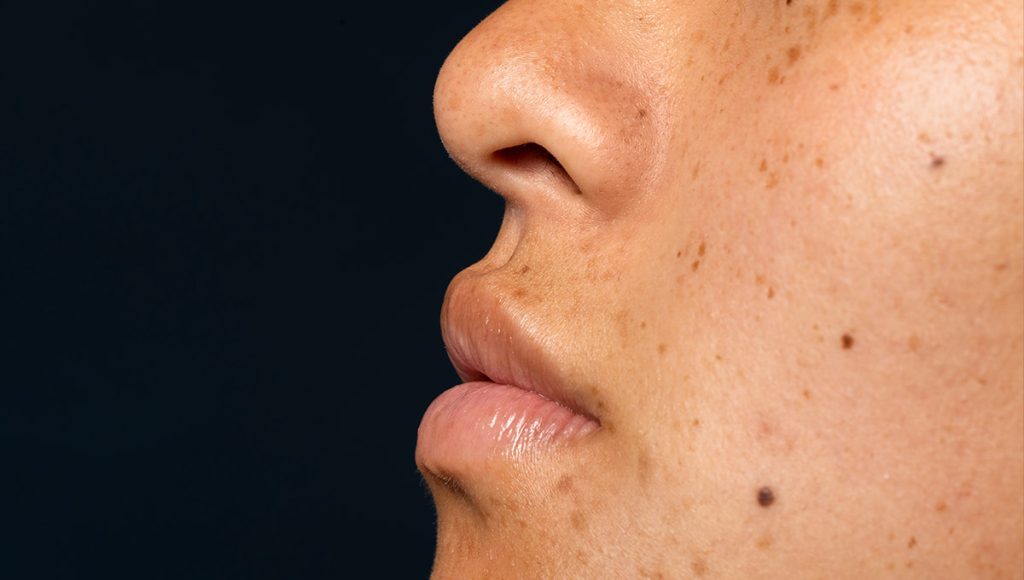
When it comes to stubborn dark spots and uneven skin, mandelic acid doesn’t just participate—it transforms.
As a go-to mandelic acid hyperpigmentation treatment, it targets the issue at multiple levels: lifting excess pigment, gently exfoliating dead skin, and reducing the enzyme that drives melanin production.
The beauty of mandelic acid?
It’s an AHA (alpha-hydroxy acid) with a larger molecular size, which means it penetrates your skin slowly—reducing the risk of irritation while still getting the job done. It’s like a patient, skilled artist, shading in your skin tone to even brilliance.
Let’s break this down more:
What is Mandelic Acid and How Does It Work?
Mandelic acid is derived from bitter almonds—but don’t let the ‘bitter’ fool you. This AHA is one of the gentlest exfoliants, and that’s exactly WHY it works so well.
Unlike glycolic acid, which can dive too deep too fast (cue irritation), mandelic acid moves at a more mindful pace.
Its large molecular structure prevents it from penetrating aggressively, making it ideal for all skin types—especially sensitive and melanin-rich skin tones.
Here’s what it does on the molecular level:
- Dissolves the bonds between dead skin cells on the surface of the skin.
- Targets melanin clusters (aka dark spots) and breaks them down gradually.
- Boosts collagen production for smoother texture.
- Promotes brighter, more even skin tone without compromising your skin barrier.
You don’t need to suffer to improve your skin.
And if you want a simple, elegant way to experience this acid? I recommend the Nasola Triple Acid Facial Radiance Pads.
These pads combine mandelic, lactic, and salicylic acid to gently resurface your skin while treating discoloration. Ideal for beginners and seasoned pros!
Try these 2–3 times weekly to start, and you’ll feel the difference—calm skin that actually looks refreshed.
Why It’s Ideal for Hyperpigmentation
Let’s talk real results—especially for skin that’s prone to dark spots just from looking at a pimple the wrong way.
Mandelic acid aids your skin’s renewal process while treading gently. This is why it’s considered one of the safest mandelic acid hyperpigmentation treatment options available today.
Here’s WHY it’s perfect for discoloration:
- Reduces post-inflammatory hyperpigmentation (PIH) without triggering further melanin production.
- Doesn’t leave behind red, irritated patches.
- Compatible with all skin types, especially deeper skin tones.
- Controls acne which often leads to scarring and spots.
And the best part? It doesn’t fight your skin; it works WITH it—every step of the way.
The Science Behind Mandelic Acid Hyperpigmentation Results
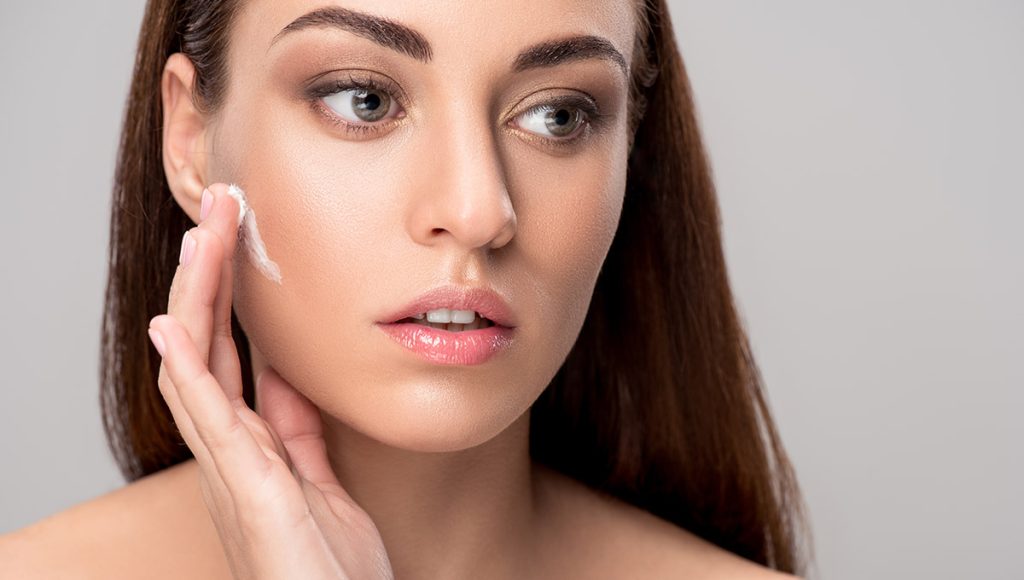
Let’s nerd out for a minute (because science is beautiful when it brings real-world results).
The reason mandelic acid is particularly effective against uneven tone is because it doesn’t just exfoliate—it works on the enzyme responsible for kicking melanin production into overdrive. Continued use actually slows down the overproduction of pigment while encouraging old spots to fade gently.
Consistency is key. But when paired with powerful partners like kojic acid? The results multiply.
Slows Melanin Production
Melanin is what gives our skin its natural tone, but excess production—especially after acne, sun exposure, or inflammation—can leave behind rogue patches we don’t want.
Mandelic acid regulates melanin by inhibiting tyrosinase, the enzyme that initiates pigment formation.
How that helps you:
- Fewer new dark spots forming over time.
- Reduction in existing hyperpigmentation.
- No rebound inflammation that makes skin worse before it gets better.
- Safe for all year-round use (with sunscreen, of course).
Think of it as turning down the volume on melanin while brightening everything else.
Supports Cell Turnover
Let’s talk about cell turnover. As we age—or if our skin is stressed (hi, winter)—dead cells pile up, making skin look dull and uneven.
Here’s what mandelic acid does:
- Boosts healthy exfoliation.
- Encourages younger cells to reach the surface.
- Fades dark patches by lifting old, pigmented cells away.
- Stimulates collagen repair for smoother skin.
To get this glow acceleration, try layering the Nasola Kojic Acid Serum over your mandelic spot treatment. Kojic acid sheds dull tone and boosts brightness—but in a steady, gentle way your skin will love.
Why Choose Mandelic Acid Over Other Acids for Hyperpigmentation?
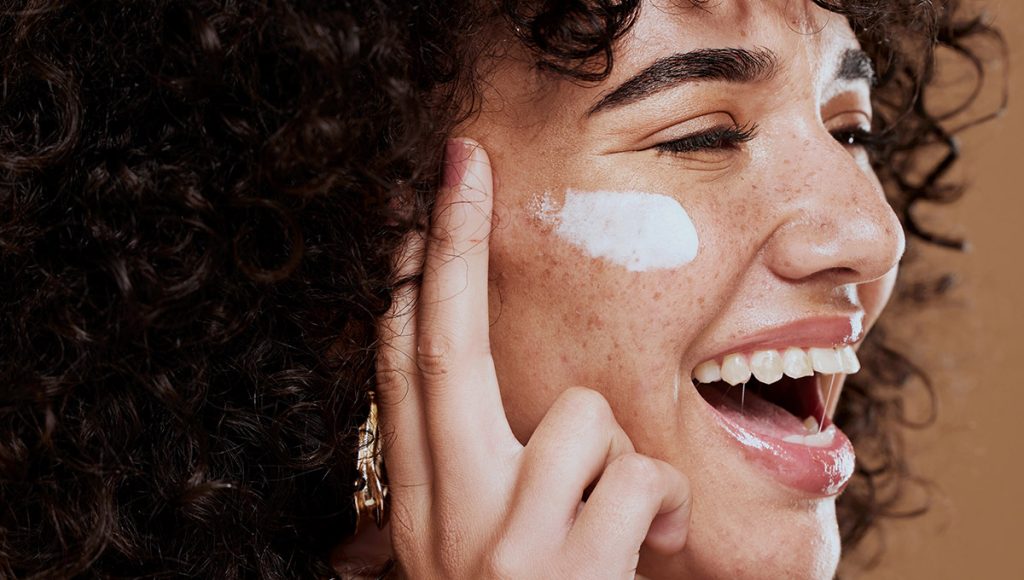
When it comes to acids, not all are created equal—especially when your skin leans sensitive, reactive, or deeper in tone. That’s where mandelic acid absolutely shines.
This quiet achiever provides all the benefits of an exfoliating acid—minus the stinging, redness, or dreaded “purging” phase.
Minimal Irritation for Sensitive Skin
No one wants a “fix” that ends in a flare-up.
If your skin tends to be reactive, or if other acids have left you red and regretful, mandelic acid offers a safer alternative.
Here’s why it’s less irritating:
- Larger molecular size = slower, gentler penetration.
- Doesn’t strip moisture or damage your skin’s protective layer.
- Reduces the bacterial component of acne.
- Improves skin texture over time without inflammation.
This makes it a dream for those with rosacea, mild eczema, or acne-prone skin that hates being poked.
Get started with the Nasola Lemon Turmeric Kojic Acid Exfoliating Pads. With turmeric’s calming properties and kojic acid’s brightening effects, these are a perfect complement to a mandelic-based routine.
Ideal for Ethnic Skin Tones
Melanin-rich skin requires unique care.
Why? Because inflammation often = more pigment, not less. That means a poorly chosen acid can set you back months.
Mandelic acid’s slow action makes it tailored for:
- Fitzpatrick skin types IV to VI.
- PIH-prone skin tones.
- Acne-prone Black or Brown skin.
- Evening tone with virtually no downtime.
Pair it with calming antioxidants and SPF and you’ve got a glow-up plan your skin will actually thank you for.
Layering Skincare Products: Maximize Mandelic Acid Hyperpigmentation Benefits
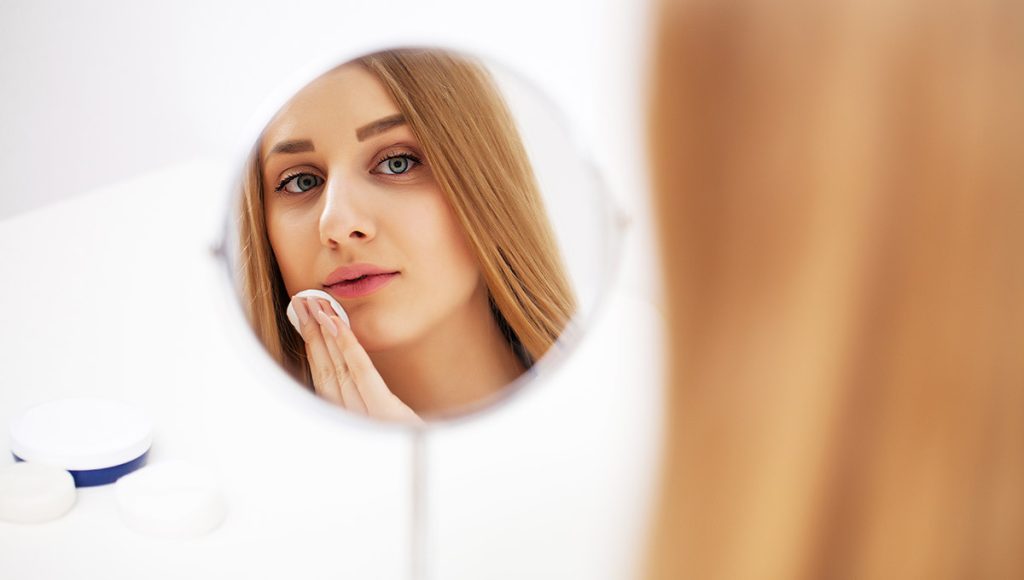
The best results?
They don’t come from one hero product—they come from a protocol. Layering your skincare intelligently can supercharge mandelic acid’s effects without overwhelming your skin.
It’s like a skincare symphony—each step has its role. When you use them in the right order, the harmony is real.
Combine with pH-Balancing Toners
Before applying acids, setting the stage is everything.
Your skin’s pH matters—and using a properly balanced toner helps the actives perform better.
Look for toners that:
- Hydrate while adjusting your pH gently.
- Soften the skin for better absorption of serums.
- Calm any pre-existing redness.
- Pave the way for ingredients like kojic or mandelic acid to dive in deeply.
I love the Nasola Kojic Acid Facial Toner for this. It checks off both boxes: prepping your skin AND adding brightening benefits.
Use in the Right Order
Skincare order matters—a lot.
Here’s the best sequence to maximize your mandelic acid hyperpigmentation treatment:
- Cleanser (use a gentle, non-stripping formula)
- Toner (like Nasola’s Kojic Toner)
- Mandelic acid (in pad or serum form)
- Brightening serum (try the Kojic Serum)
- Moisturizer (hydration seals everything in)
- Sunscreen (essential!)
Stick to this layering strategy for 6–8 weeks—and watch those dark spots fade into memory.
Ingredient Spotlight: Mandelic Acid
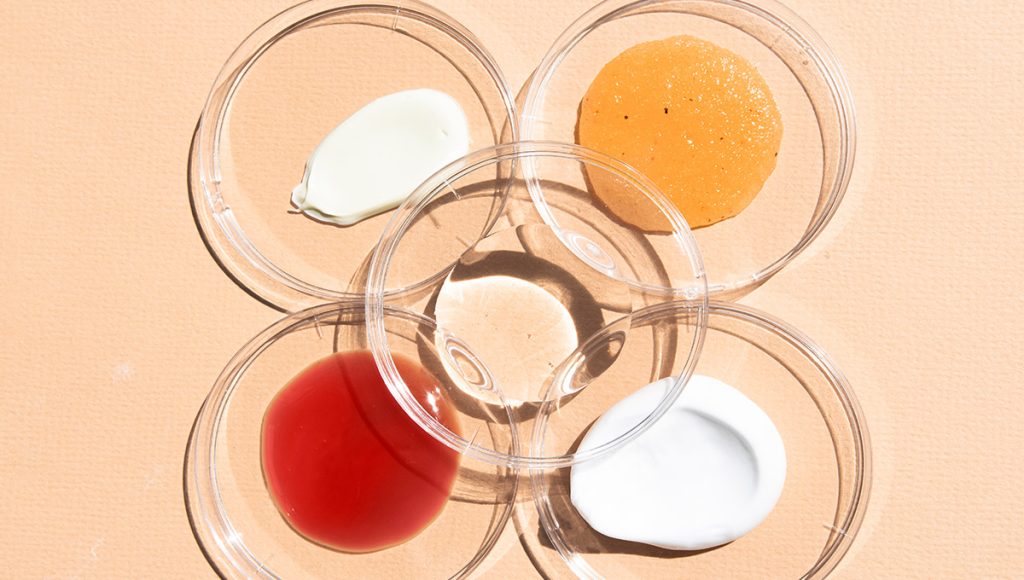
Let’s give mandelic acid its well-earned solo.
This underrated acid gets less hype than glycolic or salicylic—but don’t sleep on it. It’s incredibly effective, versatile, and easy to fold into your routine. Whether you’re a skincare minimalist or layering obsessive, this ingredient meets you where you’re at.
Benefits of Mandelic Acid in Skincare
There’s a reason more dermatologists are suggesting mandelic acid now than ever.
Let’s recap the perks:
- Gently resurfaces dull, rough skin.
- Brightens skin tone and fades hyperpigmentation.
- Treats mild acne and keeps pores clear.
- Prevents irritation caused by other strong AHAs.
And the best part? It keeps working long after application—stimulating collagen, encouraging hydrated skin, and supporting barrier function.
How to Introduce It into Your Routine
It’s best to start slow.
Even though mandelic acid is gentle, it’s still an active acid. Here’s how to add it without stressing your skin:
- Start 2–3 nights per week.
- Use sunscreen in the morning (non-negotiable).
- Skip using it alongside strong retinoids or vitamin C.
- Always follow with a moisturizer.
With time, your skin will adjust—and once it does? You’ll wonder how you ever lived without it.
How to Customize a Mandelic Acid Hyperpigmentation Routine That Works for You

No two dark spots are the same—and neither are routines. Here’s how to tailor your routine based on lifestyle, goals, and specific skin behavior.
Best Practices for Sensitive Skin
If your skin tends to overreact, simplicity and spacing out are key. Begin with a 2-day gap between active ingredients. Avoid introducing multiple acids at once.
Here’s a foundation routine:
- Gentle cleanser + Nasola Kojic Toner
- Start with exfoliating 2x/week using Triple Acid Pads
- Apply a calming serum, avoid mixing strong actives
- Finish with soothing moisturizer
- Protect with SPF every morning
What to Do If You’re Seeing Slow Progress
Not seeing overnight results? That’s normal. Mandelic acid works slowly, and consistency is what turns subtle into stunning. If you’ve been patient and still feel “meh,” try:
- Introducing Nasola Kojic Serum 3x per week at night
- Adding the Lemon Turmeric Pads once weekly for extra brightness
- Ensuring you’re not skipping sunscreen
Give this method 6–8 weeks. Your skin’s clock is different than your watch.
Conclusion
Persistent hyperpigmentation can wear you down, but mandelic acid brings hope—without irritation, harsh ingredients, or unrealistic promises. It works gradually, thoughtfully, and effectively.
Whether you’re just starting your journey or rebooting your regimen, mandelic acid hyperpigmentation relief is real—and reachable. All it takes is smarter layering, better ingredients, and consistent care.
Try curated solutions like the Nasola Triple Acid Facial Pads, Kojic Acid Serum, and Kojic Facial Toner to build a routine your skin actually responds to.
Your best skin story? It could start today.
Frequently Asked Questions About Mandelic Acid for Hyperpigmentation
Most people begin to see initial brightness within 1–2 weeks, but serious changes in hyperpigmentation typically take 6–8 weeks with consistent use. Stick to your regimen, and always wear sunscreen to protect progress.
You can, but only after slowly building your skin’s tolerance. Start 2–3 times a week and gradually increase. The Nasola Triple Acid Facial Radiance Pads are gentle enough for gradual daily use.
The Nasola Kojic Acid Serum works beautifully when layered with mandelic acid. It targets pigment clusters while calming inflamed areas.
Yes! These ingredients complement mandelic acid’s gentle exfoliation. The Nasola Lemon Turmeric Kojic Acid Exfoliating Pads offer an easy, blend-it-all-in application.
Avoid pairing it with retinol, vitamin C, or benzoyl peroxide unless guided by a skincare pro. Always follow with SPF to protect sensitive new skin cells.
While it’s not mandatory, a pH-balancing toner like the Nasola Kojic Acid Facial Toner can enhance acid absorption and increase the efficacy of your routine.
Absolutely. Mandelic acid is particularly safe for darker skin. It does not cause rebound hyperpigmentation or intense irritation, making it ideal for skin tones prone to post-inflammatory spots.
It can! Mandelic acid helps lighten dark patches caused by melasma over time—especially when paired with kojic acid, found in several Nasola products.
YES. Acids make your skin more vulnerable to UV damage. SPF is essential to avoid reversing your progress or making pigmentation worse.
Cut back. Reduce usage to every other day or switch to a gentler format like the Lemon Turmeric Kojic Acid Pads which include calming turmeric to offset sensitivity.


